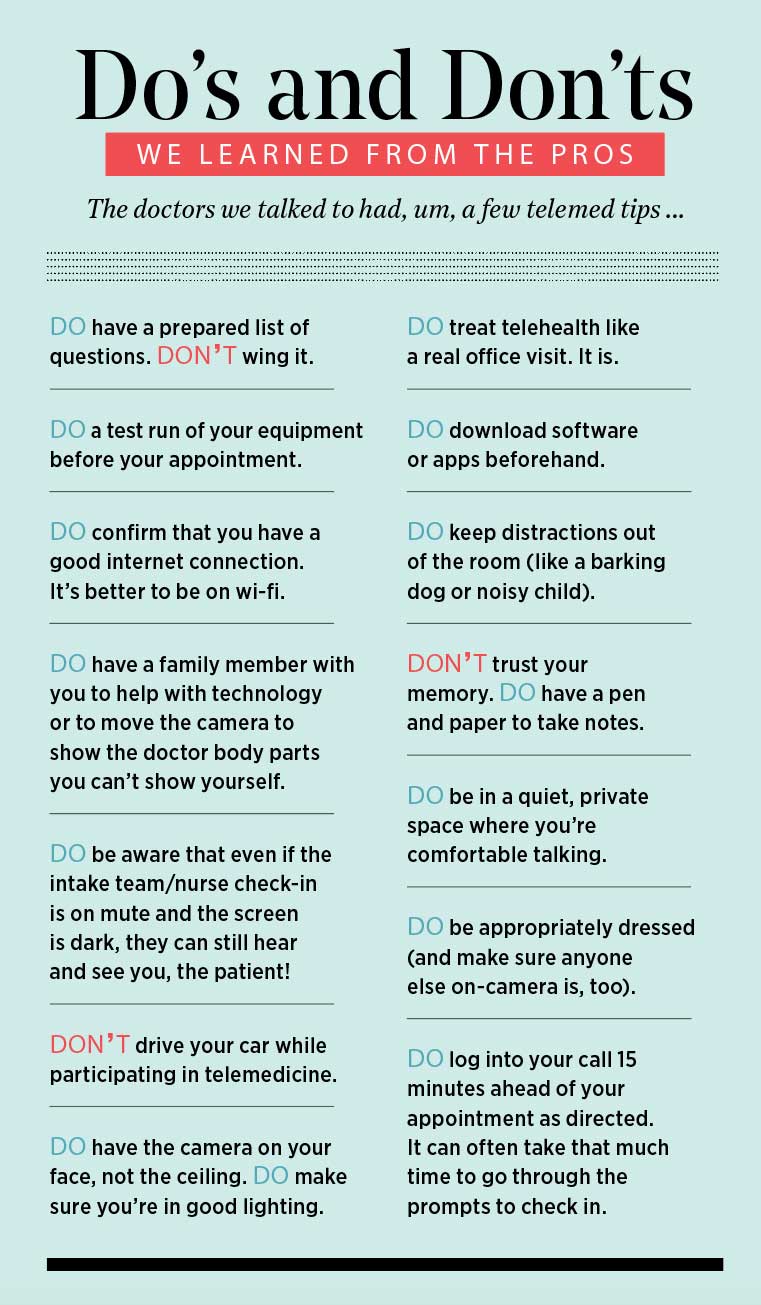Telemedicine Revolutionized Healthcare. But Its Future Is Uncertain
COVID forced the health-care system to do what it had resisted for years — offer telehealth to all. Once the emergency is over, will we keep the innovative leaps we’ve made, or retreat to the old ways of doing medicine?

Photography by Andre Rucker
Last year, at age 28, Tori Muchnik found a lump on her right breast. After an ultrasound indicated it was normal, she went back to doing that work-life-balance thing as a wife, a mother of two young boys, and the director of recruiting for the tutoring company where she works. The Merion Station resident has a warm, unflappable energy that you’d expect from someone who works with kids. Before the pandemic, she worked at Independence Charter School in Center City, teaching special education.
But when Muchnik found a lump in her left breast a few months later, she became worried. In early January, Muchnik got a mammogram, then a biopsy, and then the bad news: She had stage 1 invasive ductal carcinoma. Two days later, in a telemedicine appointment, a surgeon at Bryn Mawr Hospital mapped out the best plan of treatment and answered all her questions. By adding telemedicine appointments to her lineup of in-person care, Muchnik compressed the time from diagnosis to her double mastectomy to five weeks. Before telehealth, the process of scheduling and visiting with doctors and specialists could take up to three months.
Muchnik credits telemedicine not only for the speed of her care, but with how the format allowed for better communication and ability to process complex information during a time of high stress. “I get really anxious parking at hospitals,” she confesses. “For one of my in-person visits, we went to the wrong building and then were late, which really stressed me out. I prefer telehealth because I’m on time, and I can make sure my kids are taken care of. I’m settled and calm before the doctor gets on-screen, and I can focus.”
Telemedicine has had a slow then sudden ascendance in our lives. Phone and video appointments during these unpredictable two years provided smart ways to connect — and protect — patients and doctors regardless of physical distance. This pandemic experiment of health care from home has shown us that it can be effective and safe. The reach of telehealth and its ability to become woven into our overall care is growing. Besides video and phone calls, we’ve got Fitbits monitoring our steps, Apple watches conducting EKGs, wearables that monitor our sleep cycles, text bots that work with patients via smartphones to lower blood pressure. Telemedicine is emphatically convenient, which means more people are keeping up with preventive and non-acute care.
While remote health care isn’t for every medical situation, for certain conditions, it’s been surprisingly effective and easy to use. So now that we’ve had a taste of this mode of care, why would we ever go back? For one, we may not have a choice. When COVID infection numbers drop far enough, the federally declared public health emergency (PHE) will be pronounced over by the government, and the regulatory health emergency waivers that allowed telemedicine to flourish could be revoked. Congress passed legislation in March that extends telehealth flexibilities for 151 days after the end of the PHE, whenever that day comes. We must wait and see if permanent legislative changes will be implemented to allow telemedicine to continue and thrive. And if telemedicine remains, what have we learned that we want to continue as part of this new way of delivering health care?
Stodgy” and “change-averse” — these are some of the words I’ve heard used to describe the history of our health-care system in talking with doctors, nurses, health-care experts and patients about the future of telemedicine. In the past decade, while other industries threw themselves at innovation, tech and the internet (think about the rise of online banking, shopping, betting, dating, entertainment, etc.), health care lacked that same urgency. It was more comfortable doing things traditionally, like a wallflower at the technology dance. Before the pandemic, if you needed a prescription refill, you went to your doctor. If you had pink eye, you went to your doctor. If you wanted to discuss test results, yep, you went to your doctor.
But as we plunged into pandemic life, that changed. Telemedicine, or virtual care, which was relatively uncommon in this region pre-pandemic, has now been accepted by the masses as routine. Also known as telehealth, it includes services such as live video, chat and telephone encounters with health-care providers who aren’t in the same physical space as their patients. Telemedicine also includes “store-and-forward” transmission and interpretation of remote patient monitoring (RPM), which is typically used for chronic conditions. With RPM, a patient’s health data from wearables, implanted monitors and/or smartphones is regularly communicated to a doctor or care team.

All of these innovations became widely deployed in 2020 because they had to. This isn’t to say that telemedicine didn’t exist before COVID, but it wasn’t routine. Its early iterations have been around for decades: The telegraph was relied upon during the 19th century; Dutch inventor and physiologist Willem Einthoven wrote in a 1906 paper about his trans-telephonic transmission of electrocardiographs from his lab to a hospital a mile away; since the 1910s, the radio has been used to relay medical information to and from ships at sea and during the last century’s wars. In 1950, Penn radiologist Jacob Gershon-Cohen wrote a paper documenting his transmission of X-rays via phone wires from his office in Philadelphia to Chester County Hospital. During the Mercury space program in the 1960s, NASA explored remote monitoring of its astronauts’ health; it conducted a similar program with the isolated Papago reservation in southern Arizona in the 1970s. The tech boom in the 2000s saw the launch of telehealth start-up companies such as Teladoc and Amwell.
Along came COVID, and suddenly the old ways were untenable. The virus forced the health-care system to do what it had resisted for years—offer telehealth to all.
Early adopters of telehealth tech locally included Thomas Jefferson University Hospital, which launched its JeffConnect program in 2015, and Penn Medicine OnDemand, begun in 2017. But as Wadiya Haynes, a nurse practitioner at Jefferson Health, says, when staffers saw a virtual appointment on the schedule, it was a big deal and required them to figure out how to smoothly integrate the appointment into their workflow.
Why was so much medicine practiced in-person before 2020? Just follow the money for answers. There wasn’t a financial incentive for doctors to meet with you by video prior to the pandemic. Before the public health emergency of COVID, telemedicine appointments were reimbursed at lower rates than face-to-face visits. And in the “fee-for-service” model that defines American health care, each telemedicine appointment meant providers were taking a loss on their bottom lines. An oncologist told me she could previously spend two or three hours a day returning calls without being compensated.
In addition to telemedicine not having pay parity, it was never designed for densely populated areas like our own. Medicare’s telehealth policy law, the “originating site” law, was passed in the 1990s to improve medical care for those living in remote areas without access to specialists or basic care. By law, patients were only eligible for telehealth if they lived in certain rural areas of the country with a shortage of doctors. Counter-intuitively, once they qualified, they had to seek their virtual care from an approved location, such as a clinic, hospital or doctor’s office. This was a headache for people who lived in places such as Alaska and some Western states. But here in the tri-state area, where there’s a robust health-care presence, telemedicine simply didn’t seem essential.
Then along came COVID. The old ways were suddenly untenable; doctors’ offices closed, and people were justifiably afraid to breathe the same air as those who might be infected. The virus forced the health-care system to do what it had resisted for years: offer telemedicine for all.
On March 6, 2020, the Centers for Medicare and Medicaid Services (CMS) made a decision that profoundly changed how Americans would receive health care during the federal public health emergency. Using emergency waiver authority enacted by the U.S. Department of Health and Human Services and the CARES Act, CMS temporarily eliminated the “originating site” rule so Medicare beneficiaries could receive care from their homes no matter where they lived — city, suburbs and rural areas alike. CMS expanded covered health-care services and agreed to reimburse audio-only consultations. And, crucially, CMS would reimburse these telemedicine visits at the same rate as in-person services while waiving co-pays and deductibles. Because Medicare is such a behemoth on the insurance landscape, private insurance companies and state governments generally follow its lead, and they did this time, too. Critically, HHS relaxed HIPAA regulations so doctors could use just about any means necessary to visit electronically with their patients: personal phones, Skype, FaceTime, Facebook Messenger video chat, Zoom, Google Hangouts.
When most of us were living bunker-style in our homes, telemedicine was often the only way to receive care. We may not have wanted to figure out patient portals, come up with still more passwords, master new platforms, download apps, and figure out optimal lighting for laptops and smartphones, but we did. According to CMS data, Medicare use of telemedicine went from approximately 840,00 visits in 2019 to 52.7 million visits in 2020. “One of the gifts of the pandemic,” says Center City dermatologist and Mohs surgeon Mark Abdelmalek, “was that it blew barriers out of the way for us. Suddenly, not only was it okay and encouraged to use telemedicine, but it was actually required to provide care for patients.”
The pendulum has swung back significantly as life turns normal-ish and patients are returning to see doctors in person. “There’s some equilibrium setting in,” says Krisda Chaiyachati, a primary-care doctor and the medical director for Penn Medicine OnDemand Virtual Care until last March. “Telemedicine isn’t for everybody and every occasion. The best health-care system is one that can accommodate a variety of preferences and modalities.” Many of the doctors I spoke to used the same hardware analogy: Telemedicine is a great tool in the toolbox of care.
“Often, people say telehealth is all-or-nothing,” says Judd Hollander, a professor of emergency medicine and senior vice president of health-care delivery innovation at Thomas Jefferson University. “But as with almost everything, there’s a time and a place for telemedicine and for in-person care. Most studies show there’s not a huge new utilization, but it’s more about delivering care in a better, more effective manner.”
Telemedicine seems particularly suited to mental health needs, of which COVID has produced a tsunami. It eliminates the stigma of sitting in a semi-public waiting room or pushing the elevator button to get off on the floor for behavioral issues. Penn’s Chaiyachati calls the use of telemedicine for mental health “a total win.” “Therapy can be incredibly hard to access,” he says. “Just think of the journey to get to someone’s office. If someone is struggling with depression or anxiety disorder or is bipolar and you put them on a crowded subway, or they’re forced to travel 40 minutes one way and then back, that creates a lot of challenges. But the alternative? No commuting, and they can sit in the comfort of their home and communicate with their provider. No-show rates for mental health visits have dropped precipitously. It’s just easier.”
“We all thought telemedicine would be impersonal and limit opportunity to communicate with patients,” says Tatyan Clarke. “Actually, it affords more intimacy.”
A side benefit: Telehealth is keeping a lot of aging psychiatrists in the therapy game longer by safely extending their years of practice. “Telepsychiatry is a chance for people to get more therapy along with their medication or status checks,” says Bryn Mawr-based psychiatrist Donald Haupt, who specializes in adult ADHD. “If I were still seeing patients in my office, it would have hastened my retirement. There is value in talking more with patients, and telepsychiatry prevents missed sessions when a child is home sick or there’s a snowstorm — or a pandemic.”
Virtual care has also proven useful for treating opioid use disorder during the pandemic. Temple University Hospital’s David T. O’Gurek, a family physician with a focus on addiction medicine, actually saw improvements in no-show rates among opioid use disorder patients, which means they’re getting more care more often. His missed appointments went from 26 percent pre-pandemic to only eight percent. That number has floated back up as people get out more but has yet to reach pre-pandemic rates. That increase in care means better outcomes for these patients.
•
No-show rates are a thorn in the side of all practitioners. Researchers at Penn’s Perelman School of Medicine conducted a study, published in the Journal of Internal Medicine, that found telemedicine reduced time to follow-up care after hospitalization and improved appointment show rates among all demographics; the greatest boost was with Black patients, who increased their visit completion rate from 52 to 70 percent. The access telemedicine provides could potentially significantly improve health-care equity and outcomes (more on this health-care equity issue later).
O’Gurek warns, though, that telehealth isn’t a panacea. “Some of the value of doing a physical exam is, for lack of a better term, ‘laying on of hands.’ When you listen to someone’s heart through the stethoscope and hold your other hand on their back, it’s almost like a hug for the patient. When you see a patient in person, you can shake their hand, give a high five, a hug. We’re used to doing those things in primary care, so that’s obviously been a challenge.”
Moments of shared humanity in a shared space can be hard to replace, but the gains from the convenience of virtual care are meaningful. And as Temple Hospital bariatric surgeon Tatyan Clarke points out, what with masks and social-distancing protocols, meeting with a patient by video can actually feel more cordial these days. “We all thought telemedicine would be impersonal and limit opportunity to communicate with patients,” Clarke says, “but actually, it affords more natural intimacy.” She notes another unexpected bonus from a video visit. You know how slightly rude it feels when the doctor doesn’t make eye contact with you while busily typing into a computer during an in-person visit? “There’s not any less typing into the computer during a video appointment,” explains Clarke, “but it feels different, better, to the patient, because I can still see your face. It integrates the patient into the process.”
A study published last December in the Annals of Internal Medicine concluded that video checkups were as effective as in-person visits for patients with conditions such as diabetes, respiratory illnesses, chronic pain, heart problems, and neurological disorders. More frequent touchpoints can close gaps in care and keep motivated patients on track — and keep those less motivated in a closer orbit, for better compliance. This pays dividends in patients’ improved health, delaying disease progression and keeping them out of hospitals. Lori Noble, a Center City primary-care physician with Penn Medicine, has a patient she sees regularly for routine follow-ups. “He’s an alcoholic and was a poorly controlled diabetic,” Noble recalls. “Over the course of 2021, he really got his life together. He’s been sober, lost 100 pounds, and is no longer considered diabetic. We did a fair amount of the work by video together. He’s a father with a busy career, and he wouldn’t have been able to get into my office for monthly checks without telemedicine.”
Virtual care has been a particular boon to those with diabetes, hypertension, and congestive heart failure. Patients can be prescribed blood pressure cuffs, pulse oximeters, and wearables for arrhythmia detection, or they can use Apple watches with FDA-approved apps to transmit EKGs in real time. Home monitoring equipment and wearables may radically shift how Americans manage chronic disease. “Telemedicine increases the ability to reach out to those patients with chronic heart failure,” says cardiologist Ahmed Foda, the chief medical information officer at Temple Health Ambulatory Practices. “If they have blood pressure equipment, we can ask them for their data, but we can also take a look at their legs, listen to breathing, and ask about sleep patterns. Many things we do, we can do on telemedicine — and do it more frequently.”
Then there are those patients for whom simply getting to the doctor is a huge hassle. For Meg Judson, 54, who lives in Blue Bell with late-stage ALS, it’s not just inconvenient to travel into the city for a checkup; each trip entails renting a wheelchair-accessible van for $150, plus finding a driver and someone to keep her comfortable during the journey. Now she can video-chat with her ALS care team from home, using Tobii — the eye mouser she uses to type in questions or responses — without disrupting her routine or her home-care set-up.
Telemedicine is ideal for going over test results, discussing treatment plans, and conducting post-op check-ins. “You’d think a post-vasectomy check-in is the last thing you’d do on telemedicine,” says Jeff’s Judd Hollander. “But after you get that surgery, and if the incision looks good, a trip into the city could be a lot of bouncing around you don’t need to subject your genitalia to. It can be preferable to an in-person visit sitting in a paper gown in a cold room. Patients find it most comforting to be in a familiar environment.”
Well. There’s familiar and then there’s … too familiar. Doctors tell stories of patients who smoke cigarettes during video sessions, or eat ice cream, or have them wait while they put the dog out or finish making tea. Rene Rubin, director of Rittenhouse Hematology/Oncology, once had a patient take a phone call mid-shower. “During the pandemic, people just got kind of strange from spending so much time inside the house,” Rubin says with a laugh. “A doctor’s visit isn’t a social phone call. But, you know, welcome to the modern world.”

The modern world is populated now with digital natives who grew up with phones in their hands. People in their 20s and 30s think it’s downright quaint to call the office for a doctor’s appointment. They wonder: “Why can’t I do my health care like OpenTable?” The millennial population, younger and healthier than its parents, may not even have a primary-care doctor. They appreciate the option of getting quick virtual triage from a doctor on the rare occasions they need it.
Judd Hollander recalls being awakened by a phone call from his daughter-in-law recently: “She wanted to know if she had appendicitis.” He guided her through some physical tests. “I ended up telling her she had to go to the ER immediately for suspected appendicitis. She asked me if she could stay in bed a few more hours. I said no.” She was operated on shortly thereafter. “For her, at 5 a.m., she doesn’t have an option for the in-person visit,” Hollander says. “No doc will see her. If she had waited to call her regular doctor when business hours began, odds are her appendix would have ruptured.”
•
The question now is: What does the future hold for telemedicine? Are we about to lose the services we’ve come to rely on during this real-time experiment? Currently, we’re in a holding pattern of governmental wait-and-see. As long as the federal public health emergency remains intact, the waivers that allow the new, improved telemedicine will continue. Without it, payment parity goes away — and so will most health-care systems’ incentives to keep offering telemedicine.
The American Telemedicine Association (ATA) sent a letter to Congress in January asking for comprehensive — and permanent — telehealth reform, arguing that providers have already sunk substantial investment into its technologies but that without permanent legislative reform, future investment is uncertain. The letter neatly articulates the conundrum: “While the Biden administration may elect to extend the COVID-19 PHE, the fact that the PHE determination must be renewed every 90 days and could end later this year has introduced significant uncertainty into all parts of the U.S. health-care system.” As it stands today, providers must weigh the costs of investing in the technological and clinical infrastructure required to maintain telehealth programs at scale against the possibility that Congress may ultimately decide not to support permanently expanded telehealth coverage.
“There’s large bipartisan support to overturn that originating-site law,” explains Joseph Kvedar, the board chair of the ATA and a professor of dermatology at Harvard Medical School, “but those in Congress don’t tend to make these decisions until they have to. People in D.C. think the PHE will stay through 2022, but that’s speculative. The other likely scenario is they don’t change the law but extend the health reimbursement portion of PHE so they can ‘study’ it.”
Kvedar believes that Congress will basically give CMS enforcement discretion even if the PHE is declared over. In this scenario, the laws wouldn’t be changed, but Congress buys time, hires a firm to study telehealth, eventually presents findings to the Congressional Budget Office, and goes from there.
The doctors I spoke with cited reimbursement rates for virtual appointments as one of their top concerns for the future of telemedicine. In a recent survey by the Primary Care Collaborative and the Larry A. Green Center, nearly 40 percent of primary-care doctors said they won’t be able to continue telemedicine services if CMS goes back to pre-pandemic rules and stops reimbursing video and phone visits at the same rates as in-person ones. “The hottest topic in telemedicine is reimbursement,” says Judd Hollander. “Before the pandemic, there was very little reimbursement; during, it was fairer. But the uncertainty now prevents me and other health systems from knowing how much to grow out telemedicine. We know patients like it, and it offers advantages to some patients some of the time, but we don’t know if we can afford that if things change.”
Telemedicine won’t make the doctor’s office obsolete, but it does offer a new realm of possibilities in which better care can be provided more efficiently and equitably.
Rodrigo Cerdá, senior vice president of health services and chief medical officer of Independence Blue Cross, says, “We’ve tried to be as clear as possible: Telemedicine is here to stay. We’ve all found telehealth has an important role to play. It can increase access to patient services in a convenient way — not replacing in-person care, but it is a good complement. We want to provide reassurance that health-care providers should be investing in it and changing the way they operate.”
Some private insurers are reinstituting those previously waived co-pays for non-COVID-related virtual care. They’re concerned that over-utilization of telemedicine will drive up its costs. That seems unlikely, since patients are returning to in-person care as the pandemic drags on. “Over-utilization is certainly a concern,” says Cerdá. “One of the downsides of health care is the fee-for-service approach, where the more a provider does, the more they get paid. It rewards volume, not value.”
“The vast majority of health-care providers are still in fee-for-service models,” says Kvedar. “Fee-for-service doesn’t make sense, but try changing it.”
Remember how we said the health-care system is change-averse?
“I used to be among the people who championed telehealth as value-based,” says Kvedar, with providers paid, not for each service rendered, but by patient health goals reached. “And I still hope that happens, because it makes complete sense. But the sort of activity at ground level doesn’t suggest that’s happening now.”
Penn’s Krisda Chaiyachati posits a new model for payment that liberates docs from the anxiety of patient-visit volume to break even: “For telehealth, there’s value in thinking about how it can be folded into value-based care models like bundled payment models. In these arrangements, doctors like me could be freed up to just decide when it is the right thing — the most convenient care for the correct set of clinical conditions — to provide telehealth and be less worried about seeing more patients to break even.”
Aside from the problem of who gets stuck with the bill, there are questions of whether telemedicine promotes better health across the demographic spectrum. For example, does it make things harder for low-income and elderly patients, or easier? Does the convenience of not having to travel to an appointment balance out the frustrations of dealing with pricey, newfangled technology? There’s a risk that telemed’s innovations will only exacerbate our societal inequities. “Telehealth hasn’t created problems that didn’t exist before,” says Temple’s O’Gurek, “but it highlights important ones that we need to think more broadly about to deliver health care. Traditionally, we don’t think about the social determinants that shape health outcomes, but telehealth highlights inequalities. Think about when schools shut down, and kids were told to log into virtual classrooms. They had to go to parking lots. Why do some kids have to do that and others don’t? If we want to advance health care for our community, commonwealth and country, we need to provide quality access.”
Krisda Chaiyachati says Penn is studying tech equity issues. Device access is a huge barrier. In urban areas like West Philly, smartphone use is quite high, but broadband affordability is more problematic. He notes that video use for telemedicine is much lower among low-income patients, which could translate into worse health outcomes if insurance companies stop reimbursing phone calls at the same rates as video appointments. “There are access barriers with telemedicine, but once overcome, virtual medicine can improve show rates and care,” says Chaiyachati. “Many patients are low-income in the West Philly population, so it may not be as convenient to do an in-person appointment. A patient might take care of a number of people in an extended family, so showing up 20 minutes before an in-person appointment isn’t easy. If I’m watching my brother’s kids or my grandmother, I may not be able to afford to get childcare, and it doesn’t work for me to block out half a day for an appointment if I’m making $15 an hour.”
The City of Philadelphia’s Office of Innovation and Technology recently released a report about the city’s digital needs. While 84 percent of those surveyed had high-speed internet connections at home, only 70 percent had a working desktop or laptop computer. Only nine percent of Philadelphia households have signed up for a discount internet program, such as Comcast Internet Essentials, T-Mobile’s Project 10Million, the Emergency Broadband Benefit, or PHLConnectED. The vast majority of those surveyed were unaware such programs even exist.
Broadband internet connection is more of a necessity than a luxury at this point in the 21st century. The “haves” get better health and better education, while the “have-nots” are getting left behind. Last December, Pennsylvania lawmakers acknowledged the perils of a growing digital divide and unanimously passed a bill to help bring high-speed internet to its citizens with the creation of the Pennsylvania Broadband Development Authority. This investment of $100 million into a more equitable future was funded by President Biden’s Infrastructure Investment and Jobs Act. The authority is a part of the larger $65 billion allotted nationwide for broadband infrastructure deployment.
Whether or not Congress makes permanent changes to telemedicine regulations and the PHE is renewed, we’re in the midst of a significant shift in how health care is delivered in America. Telemedicine won’t make the doctor’s office obsolete, but it does offer a new realm of possibilities in which better care can be provided more efficiently, conveniently and equitably. We need to determine where telemedicine works best — in chronic care and mental and behavioral health, for example — and invest in those areas. And those unresolved questions of equity and access remain. Still, “Telemedicine is here to stay,” says Chaiyachati. “Patients expect it. We’re beelining toward in-home-type health care soon. We have other tech points in our homes — smart TVs, Alexas, other devices. We just have to come to grips with how much we’re willing to have some form of automation in our lives when it comes to health care.”
Best Telehealth Bets
Telemedicine is particularly suited to certain conditions, according to our experts.
These include: Acne ● Allergies ● Back & joint pain ● Bronchitis ● Colds ● Coughs ● Counseling about diagnostic & therapeutic options ● Diarrhea & constipation ● Discussion of test results ● Earaches ● Fever ● Flu ● Gout Headaches ● Indigestion & heartburn ● Insect bites ● Nausea ● New skin conditions ● Nutrition counseling Mental health counseling ● Pink eye & styes ● Services for substance use disorders, including opioid use disorder ● Sinus infections ● Sore throats ● STD concerns ● Urinary tract infections ● Vomiting

Published as “The Telemedicine Revolution is Uncertain” in the May 2022 issue of Philadelphia magazine.


